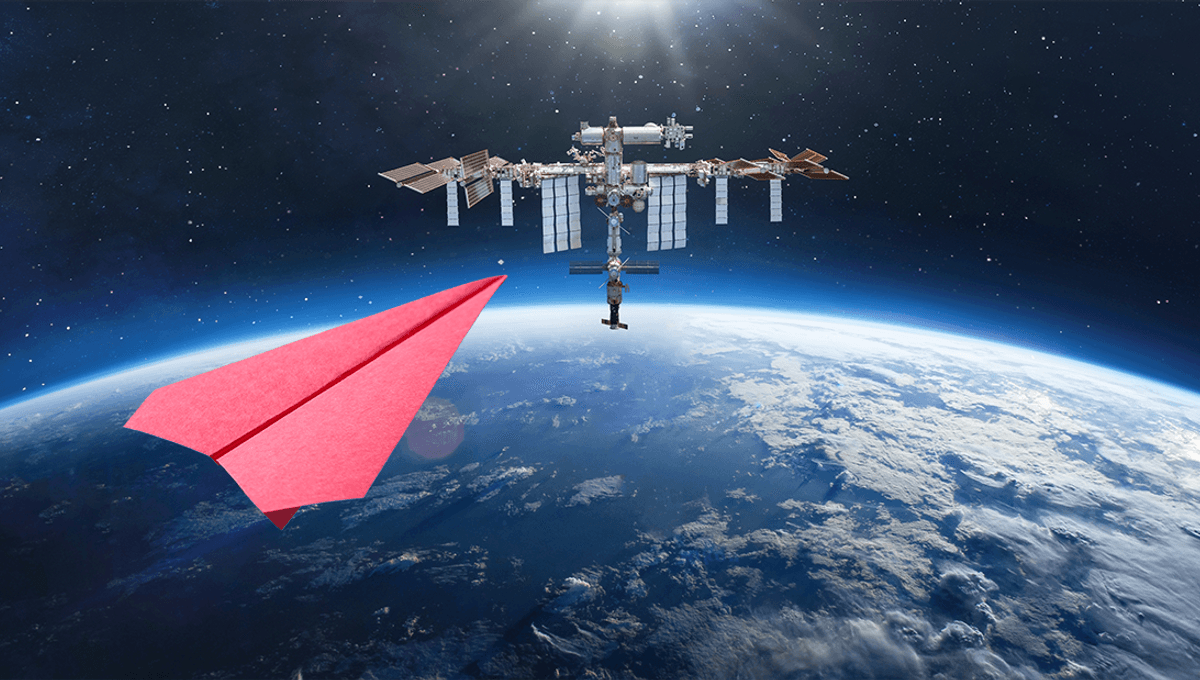-
Ροή Δημοσιεύσεων
- ΑΝΑΚΆΛΥΨΕ
-
Σελίδες
-
Blogs
-
Forum
What Would Happen If You Threw A Paper Airplane Out Of The ISS? New Study Finds Out

What Would Happen If You Threw A Paper Airplane Out Of The ISS? New Study Finds Out
The age-old question of what would happen if you threw a paper airplane out of the International Space Station (ISS) has been answered in a new paper.
Space around our planet is getting quite full. We are a messy species, and low-Earth orbit is apparently no exception to our "we'll clean up later" rule. One concern about the debris is that it could cause the "Kessler Effect" (or Kessler Syndrome). Simply put, the Kessler Effect is where a single event (such as an explosion of a satellite) in low-Earth orbit creates a chain reaction, as debris destroys other objects in orbit. Should this happen, the debris could keep colliding with other objects, potentially causing communication problems and leaving areas of space inaccessible to spacecraft. Essentially, it could end up like the film Gravity, but with less George Clooney doing great eyebrow work and more "Hey what happened to my GPS?". At worst, some speculate it could essentially trap us here on Earth, unable to leave. While there are efforts to clean up near-Earth orbit of debris and defunct satellites, some are looking into making spacecraft and satellites more sustainable pre-launch. "One research direction is into organic materials as a substitute for traditional metallic ones, to reduce the environmental impact of spacecraft at burn-up during atmospheric entry," the team explains in their new paper. "Another research direction is into deployable drag sails, to speed up orbital decay of satellites in low Earth orbit (LEO) at end of life and remove space debris. An origami (which means “folded paper” in Japanese) space plane, positioned between these trends, may offer new pathways for sustainable space utilisation and exploration." In order to explore this possibility, the team attempted to simulate what would happen to a paper airplane made from a single sheet of A4 paper if it were launched out of the ISS at a height of 400 kilometers (250 miles). In the study, the team modeled how fast the plane's orbit would decay, the plane's orientation vs its direction of travel, and how much heating the plane would endure as it headed through our atmosphere. Conducting simulations as well as tests in a wind tunnel with a slightly modified plane (aluminum was combined with paper for that experiment), they found that the plane may fly surprisingly well at first. "The space plane is statically stable about the flow-pointing direction (X-axis aligned with incoming flow) in pitch and yaw," the team writes. "This suggests it may be able to passively maintain alignment with the orbital direction during flight in the rarefied atmosphere in [low-Earth orbit]." According to the team's work, the plane's orbit would decay very quickly after deployment, and would enter Earth's atmosphere within around 3.5 days. The wind tunnel experiment showed that the plane would suffer only a little from deformation as it traveled through our atmosphere, though this isn't enough to save it. "Based on the hypersonic wind tunnel test results and simulation, surface forces acting on the space plane during atmospheric entry are not expected to cause significant deformation," the team explains. "However, the paper space plane experiences severe aerodynamic heating in the order of 105 W/m (or 10 W/cm2) for several minutes. Accordingly, combustion or pyrolysis is expected during atmospheric entry." While sending a paper airplane to burn in our atmosphere might not sound very useful, it is this disposability that the team was looking for. "The paper space plane’s strong sensitivity to aerodynamic drag in the rarefied [low-Earth atmosphere] atmosphere suggests it could be used as a passive probe for atmospheric density measurement," the team concludes. "Air density can be reverse engineered from its orbital motion. Given the short duration of atmospheric entry, data is acquired rapidly. Owing to the extremely low cost of a paper space plane, multiple deployments could be conducted at the same time, and repeated at regular intervals, providing simultaneous distributed measurements." The team suggests that paper airplanes could be used for other low-cost, low-orbit missions, if for example they were fitted with thin-film imaging systems. The study is published in Acta Astronautica.


